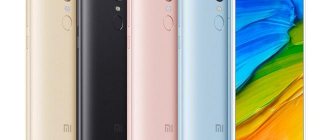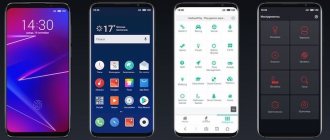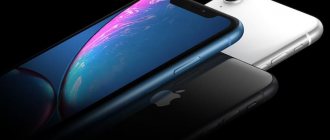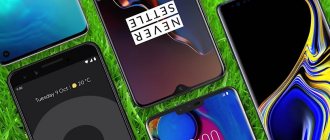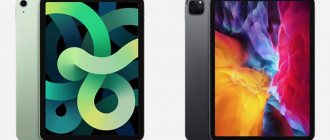Rating of this article according to readers:
4.9
(236)
After the publication of an article about OLED screens, one of our readers asked to tell us which screen of modern smartphones is better - IPS or AMOLED (also known as Super AMOLED, Dynamic AMOLED or XDR OLED).
At first, I did not plan to write detailed material about this, since I was sure that there was plenty of information on this topic on the Internet. But then I decided to do a little googling and what I found completely changed my mind.
In addition to the fact that many of the articles are written by people who have no idea how screens work, much of this material contains information that is no longer relevant and is reprinted over and over again.
In my article, I will try to explain as simply and clearly as possible how the screens of modern smartphones work, and at the end we will compare all the advantages and disadvantages of each technology so that you can make a more informed choice of your next smartphone.
Just at the very beginning I would like to make an important note. In order to avoid unnecessary complexity and make the article understandable for every reader, I will deliberately make a number of simplifications and omit some details that are not key to understanding the topic.
And one last thing. If you are not interested in all the technical details of screen design, just scroll down the article to the place where we will draw practical conclusions and answer the question - which is better: IPS or AMOLED.
What is IPS, AMOLED or Super AMOLED and why is it important to differentiate between them?
There is no need to explain why the screen is one of the most important components of a smartphone. But the problem is that screens are not simply divided into “cheap and expensive” or “good and bad”. There are two fundamentally different types of displays that are common in mobile phones today. And cost is not their key difference.
We are talking about screens based on liquid crystals (LCD displays) and screens based on organic light-emitting diodes (OLED displays). All smartphones use options of either the first or second type.
The most famous smartphones with LCD displays are Apple products, as well as mid-budget and budget Android smartphones:
- iPhone 11
- iPhone XR
- iPhone 8/8 Plus, iPhone 7/7 Plus
- Honor 20/20 Pro
- Xiaomi Redmi Note 7
- Huawei P30 Lite and others
I specifically didn't mention the word IPS because IPS is just a variation of the basic LCD technology. In addition to IPS, there are other types of screens, such as: S-IPS, LTPS, PLS, etc. But they are all liquid crystal displays and are built on the same basic principle.
If we talk about OLED screens, then they can be found on almost all flagships without exception and even in mid-price smartphones. We are talking about such popular smartphones as:
- The entire line of Samsung Galaxy S-series, Note-series smartphones and many other company devices
- iPhone 11 Pro/11 Pro Max, iPhone XS/XS Max and iPhone X
- Huawei flagships (P30, Mate 30)
- Xiaomi flagships (the entire Mi 9 line, etc.)
- Sony Xperia XZ3 and Xperia 1
- And many others
In turn, OLED screens can be divided into Super AMOLED, XDR OLED, Dynamic AMOLED and others. Apart from different brands, all these screens do not have any fundamental differences.
Thus, we can draw the following conclusion:
The screens of all modern smartphones are divided into only two types: LCD and OLED
Now let's look at how these displays work, starting with LCD or, in the narrower sense of the word, IPS screens.
What types of screens are there?
The structure of the main types of displays
Displays of modern electronics are constantly evolving. Cathode ray tubes became extinct and were replaced by liquid crystals and LEDs.
Today, at least 4 large classes of screens with their own manufacturing technology and image display features coexist simultaneously on the market.
TN (Twisted Nematic). The most affordable display that uses liquid crystals to create images, the image on which becomes visible thanks to backlighting from incandescent, fluorescent and other lamps. This class is obsolete, although in a number of use cases it has no analogues.
STN (Super Twisted Nematic) , as well as Double STN and DSTN (Dual-ScanTwisted Nematic). Continuation of LCD screens with improved parameters. They are sold under the name regular TN.
IPS (In-Plane Switching). A type of LCD that uses a more uniform and bright LED backlight.
VA (Vertical Alignment). Philips proprietary matrix, which combines the advantages of IPS and TN matrices. The characteristics are somewhere in between, as are the advantages and disadvantages. Not used in compact electronics.
AMOLED (Active Matrix Organic Light-Emitting Diode). Instead of a two-layer “liquid crystal + backlight” matrix, the technology uses a single layer of organic LEDs: they provide both color and light.
IPS Features You Need to Know About
Basic design of an IPS screen
IPS matrices have become so widespread due to the fact that they are really easy to produce. Among their advantages:
Availability. Mass production is doing its job, making it possible to use the TN matrix production factories of the past to create IPS.
Color rendition. Liquid crystals can display many colors, and LED perfectly complements the capabilities by accurately illuminating the current position of the pixels. In addition, the experience of engineers has made it possible to turn IPS matrices into the most accurate displays. True, so far the matter does not concern black color.
Energy consumption. Liquid crystals that form the image on an IPS screen consume almost no current. The main energy consumer is backlight diodes.
Durability. Liquid crystals are not subject to aging and wear. Backlight LEDs also have a huge resource.
Uneven illumination is clearly visible
However, IPS has many theoretical and actual disadvantages:
Black color. A TN matrix cannot have a pure black color: under the color emitter layer there is still a backlight that forms an image trail.
Low contrast. The low depth of black does not allow the shades of gray to be accurately separated; they are mixed. In addition, the backlight has a narrow luminosity range, which results in a low difference between the brightest and darkest pixels.
Great response time. In this case, the problem is entirely in the backlight: its LEDs simply do not have time to respond quickly.
Which is better LTPS or IPS2
Before we move on to determining the best matrix, we need to know what the similarities and differences are between them.
Common features
Displays are made of silicon. It is from this substance that liquid crystals are made, which change position according to the control electrode. Manufacturers chose silicon because it has the following useful features:
- operating temperature reaches 200 degrees;
- the material tolerates cold well;
- if you add some impurities, it will conduct current;
- the material is easy to process;
- In nature, silicon is found in larger quantities than other semiconductors.
Both matrices have a wide viewing angle. The display helps the user sit comfortably in front of the TV, computer or phone, looking at the image.
Similar structure. Both technologies are made on almost the same principle; they include filters, crystals, LEDs and electrodes.
Differences
Matrices have different numbers of elements. Companies care about how displays are made, so they strive to simplify the process as much as possible. That is why during manufacturing the quantities of all parts of the technology are taken into account.
The IPS display circuits are on the top of the screen. From them there are 4,000 contacts to be combined with the driver. With LTPS, some circuits are located directly on the glass, so the number of contacts is 200 less, making them easier to produce.
Reducing the number of contacts led to a reduction in panel dimensions. This has increased the ways in which the display can be used.
Different response speeds. LTPS has 2 times the response of IPS. This happens due to a simpler device and greater dynamism of electrons.
Varying prices. An LTPS display is more susceptible to processing than an IPS display. Thanks to this, its sensitivity increases. In addition, the price is affected by the number of contacts and the placement of some circuits directly on the glass.
AMOLED Features You Need to Know About
Basic design of an AMOLED screen
In turn, [A]MOLED has its own set of diseases: independent LEDs are both harmful and beneficial. So, among the advantages:
Separate pixel glow. One pixel is one LED that stays off when displaying black, providing nearly infinite contrast.
High speed. Separate pixel control helps achieve higher frame rates, which are achieved through fairly complex control circuits.
Low power consumption. Dark areas for AMOLED require less power consumption, while black areas consume nothing. Conversely, white color is extremely ruinous for them.
Uneven LED size leads to artifacts
However, existing technologies leave a number of “childhood diseases” that cannot yet be eliminated.
PWM All LEDs glow in pulses. This becomes noticeable at low display brightness. In IPS this is solved by rows of synchronous backlighting, but in AMOLED you have to look for a balance: either a bright glow with a blue tint (it is better visible to the human eye), or a low frequency of “blinking” diodes (high strain on the eyes).
White balance. Blue LEDs burn out faster due to technological features, so AMOLED screens suffer from incorrect color display (sometimes as a preventative measure).
Memory effect. A static picture causes OLEDs to lose brightness, which leads to artifacts over time.
PenTile. An attempt to solve the problem of blue LEDs led to the use of a different number of subpixels. And this is visible at low brightness.
AMOLED display: what is it?
We continue to understand the features of modern display modules used in smartphones. Here you will find an article about IPS screens. And in this material we will talk about AMOLED matrices.
How the screen works.
The module is based on organic light-emitting diodes, each of which is illuminated independently. Therefore, the screen does not have a separate backlight layer, which significantly reduces the thickness of the part. In addition, this technology reduces power consumption, so the smartphone battery drains more slowly than in the case of IPS or TFT technology. The part structure looks like this:
- Top layer of cathodes.
- An organic layer of LEDs, with no air gap between the elements, so perfect contact is ensured.
- A layer of thin-film transistors responsible for controlling diodes.
- Anode layer.
- A silicone or metal backing that acts as the base of a part.
The location of subpixels in the matrix may be different. Initially, Samsung, which until a certain point was the only one producing such screens, used a PenTil checkerboard design. This distribution made it possible to reduce energy consumption as much as possible. However, over time, the order of subpixel placement changed depending on the tasks at hand.
AMOLED or Super AMOLED. What is the difference?
Recently, Samsung is increasingly installing Super AMOLED matrices in smartphones. The main difference between the new generation screen is the absence of an air gap, but after 2010 it disappeared in standard modules. Therefore, today Super AMOLED is nothing more than a marketing ploy used by the manufacturer to attract buyers to its own products. Functionally, both types of displays are identical.
Now other companies are mastering the production of display modules using new technology. Many South Korean manufacturers have managed to create flexible solutions. Even Apple has repeatedly stated its intention to open its own plant for the production of such components, but this is planned to be done no earlier than 2020.
Advantages of display modules.
The main advantage is the minimum thickness. The technology allows the production of ultra-thin solutions, which is especially important for fitness bracelets, trackers and smart watches, where the size and weight of the module is important.
Another advantage is low power consumption. Since all pixels light up independently of each other, power consumption is significantly reduced. This increases the autonomy of any device.
Also, the advantages of the screen include high contrast. This property is also ensured thanks to independent LED illumination, as well as the absence of an air gap. Compared to an IPS panel, an AMOLED panel produces deeper, richer blacks.
Using a smartphone with a new generation display is comfortable even in bright sunlight, when other panels noticeably dim. The technology will allow you to view images in detail even on a clear day without setting the brightness to maximum.
Results.
Experts are confident that the future of smartphone manufacturing lies behind such screens. Modern panels have practically none. These are bright, contrasting matrices that convey the picture as realistically as possible. The only drawback of the part is the high price due to the complexity of the production process. But we will solve this aspect over time. Increased production by third-party manufacturers will definitely affect pricing, and the cost of the part will decrease in the future.
How and what will we test?
For the purity of the experiment and the most correct comparison of the 2 types of screens, we will test smartphones. They are the ones who use the highest quality matrices: small displays are easier to make than huge TV panels.
The test subjects will be 2 Xiaomi smartphones: in the left corner of the ring is a Mi 8 with an AMOLED matrix, in the right is a simplified Mi 8 Lite with an IPS screen.
The belonging of devices to one manufacturer and generation gives a rough idea of the development of technologies in a cross-section.
The more affordable Mi 8 Lite is cheaper, not least thanks to the screen, but to maintain its position, the sub-flagship must be equipped with the highest quality matrix. No worse than the flagship.
Conclusion
The advantages and disadvantages of AMOLED panels are constantly debated. But it cannot be denied that such displays are the technology of the future, as more and more mobile manufacturers are starting to switch to the new standard, invest in its development, or even release their own versions of OLED screens.
If you are lucky enough to own a smartphone or other mobile device with an AMOLED display, we can advise you to stick to a dark home screen and interface design. This will reduce the energy consumed by the screen and extend the life of the display. Be careful when doing this and remember that even with minor damage the screen can fail completely.
( 11 ratings, average: 4.82 out of 5)
Brightness and operating features
IPS screen of Mi 8 Lite (left), AMOLED screen of Mi 8 (right)
The smartphone screens are completely identical in size and resolution, differing only in the size of the “cutout” for the front camera. This allows you to view the parameters in detail.
And we will do this not in the laboratory, but in combat conditions of complex lighting, it’s more visual and interesting. Especially when it comes to what matters most: brightness, backlight uniformity and image clarity.
Mi 8 AMOLED screen
As you can see in the photo above, even the OGS screen (without an air gap) of the Mi 8 Lite has more glare. The reason is 3 layers of the screen: protective glass, a layer of liquid crystals, backlight.
A more uniform backlight allows for greater visible color density, which looks “bolder” on the Mi 8 with AMOLED. The thing is that brightness, contrast and dynamic range are indeed higher even at similar levels.
IPS screen Mi 8 Lite
If you pay attention, the fonts on the AMOLED screen are clearer and more sharply drawn. Moreover, in cases with complex colors, dull shades.
However, background areas on the LCD display are better developed, soft transitions are brighter and more distinguishable.
Artifacts that are not visible
Mi 8 AMOLED screen: Pentile
Macro shots, even at maximum brightness, reveal the shortcomings of each type of display.
The OLED matrix used by Xiaomi shows off its structure. The eye usually doesn't notice uneven pixel brightness, but the white background and the camera show the defect.
The same Pentile, which is typical for all similar screens, may or may not be visible. But one way or another, this structure is used in all mass displays.
Mi 8 Lite IPS screen: visible pixel grid
The liquid crystal matrix shows its structure in any color, at any brightness. But the pixel grid does not strain the eyes, unlike uneven brightness.
In addition, increasing the backlight frequency beyond 60 Hz practically eliminates the main drawback of the IPS panel. With AMOLED this trick is more difficult, but still irritates the eyes.
Color: where is the right one?
Mi 8 Lite IPS screen (left), Mi 8 AMOLED screen (right), cool color scheme
With the colors of different types of screens, everything is not as smooth as it seems. It is widely believed that AMOLED has a poisonous gamma, IPS is better adjustable and offers the most accurate gamma.
In practice, everything is confirmed by the human eye and turns out to be exactly the opposite when studied through optical instruments.
Mi 8 Lite IPS screen (left), Mi 8 AMOLED screen (right), standard color scheme
It's all about the insidiousness of the protective glass coatings: the developers managed to “soften” the white on the Mi 8 AMOLED panel using an oleophobic coating.
The same anti-greasy coating on the glass of the Mi 8 Lite gives the opposite effect, seriously distorting the gamma into a cold spectrum.
This behavior occurs with any color gamut settings. What's the matter?
Mi 8 Lite IPS screen (left), Mi 8 AMOLED screen (right), warm color scheme
The screen of the Mi 8 Lite has too much glare due to the split structure, while the gamma of the Mi 8 does not need correction. The absence of layers allows the display to show what the developers intended, regardless of external conditions.
Macro photographs only confirm what has been said. Adjusted for overall brightness, the Mi 8's brightness levels are always higher.
AMOLED or IPS
AMOLED or IPS
In terms of power consumption, at certain operating moments the IPS model prevails.
For example, when there is a lot of white color on the screen of a phone with the display in question, the energy consumed is twice as much. This does not happen in IPS phones .
When working with a black screen, the energy consumption indicators are approximately the same. During normal operation of the device, IPS also predominates in the energy charge.
For some it is more convenient, but when using a phone that has a built-in amoled display, the brightness goes through the roof. It's a little disturbing.
And with prolonged use, the eyes hurt and dry out. In IPS, with a more gentle color gamut, there are no such problems.
However, if you examine the phone's response speed to your manipulations, IPS phones respond much slower .
Its positive side is that the screen conveys more natural colors. But when photographing on the sunny side, the device clearly lacks brightness.
back to menu ↑ back to menu ↑
Let's look at it from an angle
IPS screen of Mi 8 Lite: transparent colors, correct white
A more careful study at close range changes the position of the liquid crystal matrices: now AMOLED glares, IPS does not.
Only then does it become clear that there is no real difference between the white balance of screens, it all depends on external distortions and perception.
Selecting a different lens and shooting conditions will turn the situation in a different direction. Therefore, it is the structure and refresh rate that will determine the quality of color rendering.
AMOLED screen of Mi 8: rich colors, correct blacks
In this case, AMOLED will have a hard time, since increasing the shooting speed will leave the white color white for IPS, and iridescent for the organic LED matrix.
Returning to the title, it should be noted: there are no visible problems when changing the viewing angle for both types of matrices. Not surprisingly, the refresh rate and pixel density are too high.
At low resolutions, IPS will demonstrate black problems at an angle.
